 |
Continental Express |
Personnel
Mission Reports
Aerial Tours of Nazi Europe for Ground Personnel at the War's End
Shortly after VE-DAY, in May of 1945, as a way of showing appreciation for the ground personnel's efforts, the 303rd Bomb Group dispatched several low-level flights over Europe. These flights were to give the ground personnel a first hand view of the results of the bombing missions, in which they played such an important part. The official flight script, describing the views seen from the planes and telling a story of what the targets were, is transcribed below with many of the official photographs.
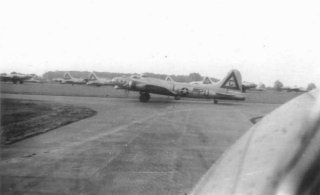 Ready for Take-off |
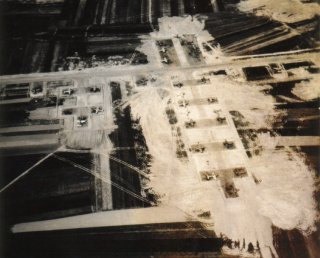 P-47 Base |
The point of departure from the English Coast at Dungeness is one which was frequently employed on operational missions. The 37 mile leg across the English Channel at the westerly end of the Strait of Dover is over a water stretch which was the scene of many ditchings and much Air Sea Rescue Activity.
The point of landfall on the continent of Europe is at Le Touquet, a peacetime beach resort. The town itself was not one of this Group'‘s targets, but two days before "D"" day either as a feint or practice operation gun emplacements on the coast just south of the City were attacked by the Group. The railroad bridge just south of Etaples (2 miles east of Le Touquet) was also one of our targets.
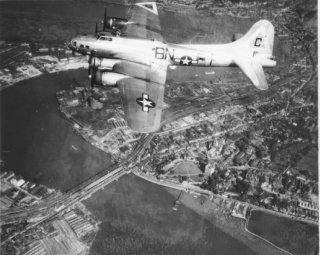 B-17G 43-38609 |
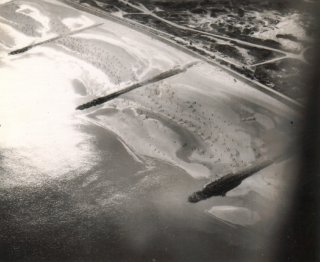 Normandy Beach |
The "Buzz-Bomb" Coast stretches 300 miles from Ostend, Belgium, to the Cherbourg Peninsula, with a depth averaging 20 miles. First "Buzz-Bombs" launched 12 June, 1944. The U.S.A.A.F. and R.A.F. dropped 48,674 tons of bombs on the Calais area up to 16 July, with the result that 80% of the sites were destroyed and further construction abandoned on the 96 sites discovered in the period. All together, 4,059 flying bombs were launched between 12 June, and 21 July, 1944; 3,045 of these landed in England, 1,512 reaching London with the result that 3,875 people were killed and 24,960 injured. Between 28 February, and 30 August, 1944, twelve flying bomb sites were attacked by this Group.
The large wooded area north of Abbeville is the Forest de Crecy. The numerous heavy flak installations concealed in the forest caused our bombers quite a bit of trouble during the 12000' and 14000' raids on the V-1 sites.
ABBEVILLE: Abbeville is situated on the Somme River, and has a population of approximately 25,000. The airdrome to the North of the town area is one made famous by the expert pilots of the "Hermann Goering Squadron" who flew the yellow-nosed FW 190s. The "Abbeville Kids" intercepted this Group numerous times, and their base was attacked by this Group on 10 July 1943. The Marshalling yard in the town was very important in the supply of the flying bomb sites.
The Poix Airdrome is directly on course 21 miles south of Abbeville. This field was directly on course for a load of bombs from this group on the 10th of July in 1943 but in those days only visual bombing could be done so because of the cloud cover all bombs were brought back to base.
BEAUVAIS: Only 41 miles from the center of Paris was important to the Germans because of two large aerodromes, one to the North and the other to the North-East. To the South, about 15 miles, (Amblainville), should be observed a large Chateau, which, during German occupation, was the G.A.F. Signals Headquarters. Quite prominent to the West and Southwest are two ‘Champs de Tir' -- shooting grounds which in peacetime were probably game reserves. One main railway line, which runs into Paris, (lying Northeast to Southeast), can be seen.
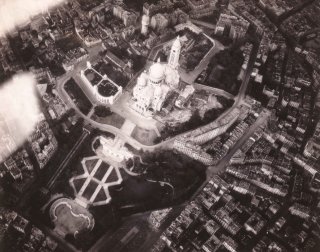 Sacre-Coeur Church, Paris |
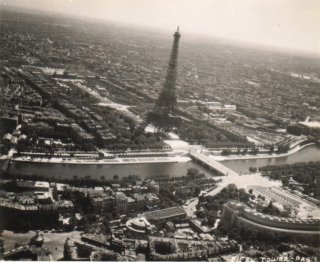 Eiffel Tower, Paris |
PARIS: Paris, on the Seine, capital of France, with a pre-war population of 3,000,000 is a city of miscellaneous industry. The center of the city is situated on the third large bend in the Seine. Coming in from the North, just off the second bend of the Seine, to the left is Le Bourget Airdrome, which was attacked by this Group on 16 August, 1943. If not too well bombed, the white star where Lindbergh touched his wheels here from his trans-Atlantic flight, should be visible. From the center of the city the widest avenue in Paris can be seen parallel to the Seine and running Northwest -- Champs Elysees. Just Southwest of the beginning of the Champs Elysees on the opposite side of the river is Notre-Dame Cathedral. At the North-east end of Champs Elysees at the junction of streets is the Arc de Triomphe. Directly South of this, on the wide bend of the Seine is the Eiffel Tower. Looking South, along the Seine from the Eiffel Tower, the large area of the Renault works can be seen nestled in the bend. We attacked this plant in April 1943. At this time Paris was well defended with approximately 250 guns. However only one plane was lost in the six attacks on Paris and vicinity. Further south along the same line is the Villocoublay Aerodrome. The aerodrome was attacked three times by this Group during the months of June and July of 1943.
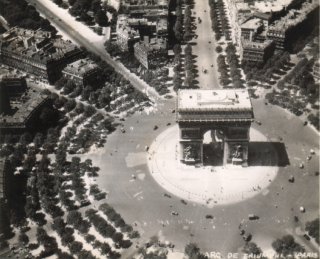 Arc de Triomphe, Paris |
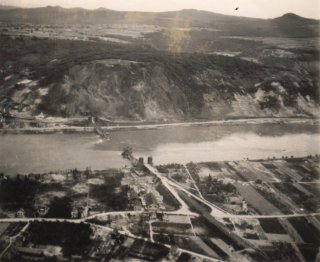 Ludendorff Bridge at Remagen, Germany |
After leaving Paris the course parallels the Marne River for approximately 85 miles. This is the river that made headlines in the first war. In this war our troops under the command of General Patton only hesitated here and quickly drove on across it. The small city of Chateau Thierry is 6-1/2 miles left of course and on the Marne River. If it can be distinguished you will see the scene where very heavy fighting took place in World War I.
Thirty miles beyond the Marne River the course crosses over the Aisne River and the large wooded area on its east bank is the Argonne Forest. It was in this area between St. Menehould and Verdun where many of our fathers remembered the last war all too well.
VERDUN: Verdun is situated on the Neuse River, 25 miles South of the Belgian border. In World War I it was the scene of a great battle to stop the German drive on Paris. In this war it was an important supply center for the 12th Army Group.
METZ: Metz, on the Moselle River, has been the most strongly fortified city on the continent since ancient times. This Group attacked Metz and area 3 times in 1944. One attack in the area was in direct support of the ground forces of the 3rd Army in storming this fortress. One of our best marshalling yard bombing occurred here.
SAARBRUCKEN: Saarbrucken is the first town on our route in old Germany. With a population of 130,000 it is the largest city in the Saar area. This is an important marshalling yard and R.R. workshops location. Consequently it was the target for this Group three times in 1944. It is a point on the Siegfried line and the dragon teeth (tank obstacles) may be visible.
ZWEIBRUCKEN: Zweibrucken is a small city of 28,000 in the Saar Basin. It is largely an administrative center and of no important military value. This city is also a strong point on the Siegfried line. Pirmasens is 5 miles right of course and just inside Germany. This is where our group's famous "Shoe Factory Bombing" took place. The target was attacked as a last resort on 9 August 1944. The target was not hit that day but the little town caught hell and even the city hall had direct hits. On the east side of the Pfalzerwald (a wooded mountainous area beyond Pirmasens) 4 miles ESE of Neustadt is the site of the Lachen/Speyerdorf A/D. It may not be visible because of the absence of runways but it was the target of this group at one time. It was actually an uneventful mission with only fair results.
 Rhine River Bridge |
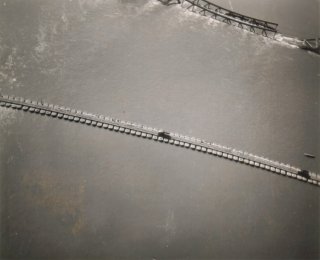 Rhine River Pontoon Bridge |
LUDWIGSHAFEN-MANNHEIM: Ludwigshafen-Mannheim is formed by the twin towns of Mannheim and Ludwigshafen, and is an industrial centre of great importance, which lies on either side of the Rhine at the confluence of the Rhine and Neckar. The largest chemical firm in Europe can be seen along the Rhine on the west side of the river. We attacked targets in these two towns 12 times with 5 losses. Three of the attacks were against the R.R. bridge connecting the 2 cities. Just east of Mannheim you can get the first sight of one of the German autobahns (6 to 8 lane super highway).
ASCHAFFENBURG: The town is built mainly on the east bank of the River Main. There are a number of small industries. This group attacked Aschaffenburg once.
HANAU: Hanau is on the right bank of the Main only 10 miles east of Frankfurt. The industries, though few in number, are of high relative value to the German war effort. The M/Y in this city was also an important target.
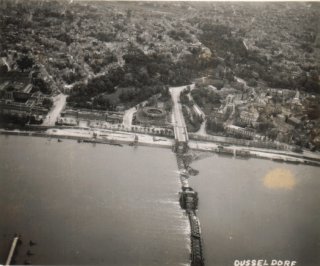 Dusseldorf, Germany |
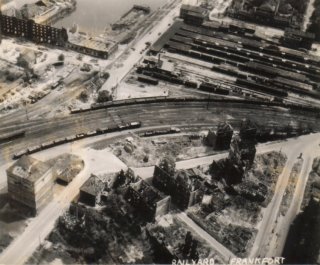 Railyard in Frankfurt, Germany |
FRANKFURT: Most frequently bombed target by PFF means. Frankfurt is the commercial, industrial and cultural metropolis of the upper Rhineland, an important transport center and a military training center. The chemical plan headquarters of I.G. Farbenindustrie is situated 5 miles west of the town. Extensive marshalling yards and railway repair shops are also in Frankfurt. We visited Frankfurt in 1943 and 1944 nine times for a loss of 3 planes. North of Frankfurt is Heddernheim -- largest propeller factory in Germany, attacked on 4 October 1943 with 1 lost.
Halfway between Frankfurt and Bingen is the town of Wiesbaden. Just before reaching the town area you will observe an aerodrome, which this Group attacked on 15 August 1944. This mission cost the Group nine bombers.
BINGEN: Bingen is a small town of 22,000 on the Rhine. It is on a main line railway. This was the embarkation point for German soldiers going to the Western Front. Concentrations of troops in the Marshalling yard here have been hit by our group.
Six miles south of Koblenz on the east bank of the Rhine River at the Lahn and Rhine River junction you can see the Oberlahnstein Marshalling yard. This target was attacked by the group on 2 December 1944 with good results.
KOBLENZ: Koblenz is an important rail center situated at the junction of the Moselle and Rhine rivers. The Moselle river valley, so skillfully carved by Gen. Patton, who drove in from the south and east, and Gen. Patch, who drove down from the north, was supplied mainly through this city, Koblenz, which had a population of 86,000. Three main marshalling (freight) yards in this area had a capacity of 6,600 wagons (cars) per 24 hours. Koblenz had been the target of this Group 5 times. This city was also the center for the Rhine wine trade.
A short distance north of the midway point between Koblenz and Bonn is the location of the Remagen Bridge. Everyone knows the story of the bridge and the river crossing that the span made possible. It was also an important structure for the Germans in aiding their Ardennes offensive. Many of their troops and supplies crossed over the bridge on their way up to the front. Notice the rugged terrain to the east and west at this point. This was the country that our 1st Army had to fight through and it was in this same country that our bombardiers had to find and hit small rail junctions and marshalling yards.
BONN: Bonn, like Koblenz, was also an important rail center supplying the area of Euskirchen and Duren, both targets of this Group. Lying in the area west of the Rhine and east of Aachen, Bonn, however, is chiefly a University city but contains a few small industries, including metals, chemicals, engineering and foodstuffs. Marshalling yards in Bonn have been the target for this Group two times with no losses. Bonn/Hangelar Airdrome, 4 miles northeast of the City was the target for this Groups' 300th mission.
The Wasseling Synthetic Oil Plant is located on the west bank of the river half way between Bonn and Cologne. This plant was bombed many times by this and other groups and it was finally completely knocked out. Two of our aircraft were lost over this target.
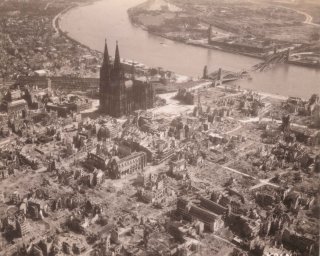 Cologne, Germany |
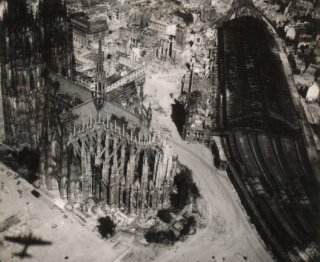 Cologne, Germany |
COLOGNE: Cologne, center of trade, traffic and political activity in the Rhine province, once had a population of close to one million people. It is the main railway center in the Rhineland and its numerous marshalling yards and rail branches have frequently been targets for this Group. In addition to its importance as a traffic center, Cologne was an extremely vital centre of industry, particularly of the engineering type. Ten raids were made on targets in Cologne and its environs and a total of 3 aircraft were lost by the Group. The famous glide bomb attack was made on this city.
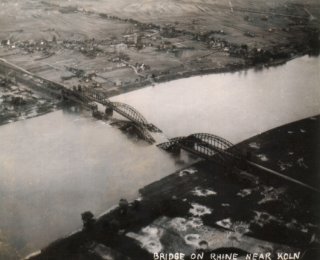 Bridge on the Rhine near Cologne, Germany |
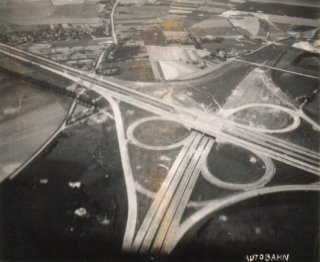 Autobahn Highway |
SOLINGEN: Solingen is a city of about 160,000. Its chief industry is engineering and in this connection it is called the "Sheffield of Germany." It is also a great producer of chemicals and explosives and is vital as a transportation center.
Hagen and Schwerte, 2 marshalling yards in the southeast section of the Ruhr were targets of this group attacked by blind bombing equipment.
HAMM: Hamm with a population of 60,000 is the eastern gateway to the Ruhr Industrial sites and operates the largest marshalling yards in Germany. In addition, numerous engineering concerns are located here. In 6 missions by this Group, A/A gunners near Hamm have caused two losses. The R.R. bridge at the north end of the M/Y was attacked by us as a T/O and hit. A moving train was almost bagged that day.
RECKLINGHAUSEN: Recklinghausen, a northern Ruhr city of 90,000 population, bounded by two of the most active canals in Germany, Dortmund and Rhein-Herne. Coking plants in the city were targets for this Group.
GELSENKIRCHEN: Gelsenkirchen is another coal and coking center of the Ruhr valley, with numerous electrical power stations supplying the Ruhr industries. Industrial haze and smoke screens often prevented good Visual sighting in this area. Our bombers made many trips through the intense flak to hit two synthetic oil plants in this area.
ESSEN: Essen is the great armament center of the Ruhr, the home of Krupps Works, where 200,000 of its 1,150,000 inhabitants were employed. Since the encirclement of this industrial area the German was machine has steadily crumbled into its present back-to-the-wall status. Duisburg to the N is Germany's largest inland seaport -- also a target.
MUNCHEN-GLADBACH: Munchen-Gladbach, a city of 130,000 employed chiefly in textile and engineering industries located in the western Ruhr is an important rail junction for Northwest Germany and Holland.
AIX-LA-CHAPELLE (AACHEN): Aix-La-Chapell (Aachen), first important German city captured by the U.S. First Army , is one of the oldest cities in Germany. Its population of 165,000 resided in this closely built city which has largely preserved its medieval character. It was a main hinge of the Siegfried Line and here again signs of the defenses may be visible.
LIEGE: Liege, the main rail and road junction of eastern Belgium, is 20 miles inside Belgium from the German border. Our Group attacked railroad bridges in this city with good results. The Le Culot A/D is located 35 miles beyond Liege and 3 miles to the left of course. This field was hit by this Group on 30 June 1944 in support of the breakout after the D Day landing.
BRUSSELS: Brussels, the capital of Belgium, is a very large city and although it is 10 miles right of course it should be visible. Out aircraft have made numerous attacks on the 2 airdromes and large marshalling yard northeast of the city.
Between Brussels and Lille is the area through which the German armies swept into France both in this war and the last. It was also in this area that the once strong German armies drove the English army back to Dunkirk.
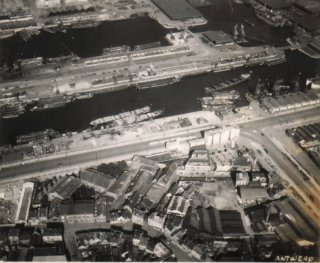 Antwerp, Belgium |
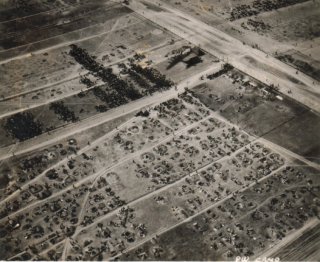 POW Camp |
LILLE: Lille, with a population of 120,000, located close to the French-Belgium border, is an important steel manufacturing town with rail lines linking it with the coast at several small channel ports. Three missions to this city have cost us on A/C.
ARMENTIERES: 8 to 9 miles WNW of Lille is a small town with a well known name in song. It is in France but the north edge of the city is the borderline between France and Belgium.
ST. OMER: Is getting back into the buzz bomb country again. On the rail line 3 miles SW of the town there is a large construction works. -- WIZERNES and was believed to be designed for use in connection with V-2's. 20 miles N (probably not visible) is Dunkirk the last German held port in north France.
WATTON: Watton is a V-2 fuel storage site and one of our earlier targets is located in the second large wooded area NW of St. Omer, 1-1/2 miles to right of course.
On leaving the French coast Cape Gris Nez is just 2 miles to the left. The tip of the cape is the closest continental point to England. It is 21 miles to Dover and it was from this Pas de Calais area that Jerry shells were fired to land in Dover.